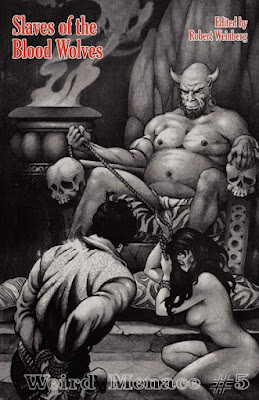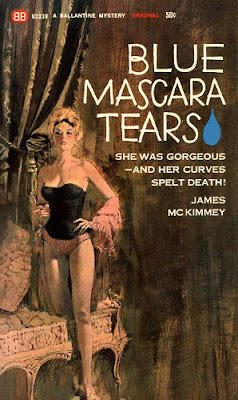This is a modern-day reprint published by Wildside Press of
a collection originally edited and published by Robert Weinberg in 1979 that reprinted
four Weird Menace pulp stories from the Thirties. The Weinberg edition has
a very nice cover by Stephen Fabian that the Wildside Press reprint also uses. This
collection features four authors who were million-words-a-year guys, or close
to it, anyway.
The author who leads off this collection, Arthur J. Burks, definitely produced
more than a million words a year for a number of years during the pulp era. He
wrote all types of stories, as well: detective, aviation, adventure, science
fiction, even a few Westerns and sports yarns. He was a prolific contributor to
the Weird Menace pulps. His story “Slaves of the Blood Wolves” appeared in the
December 1935 issue of TERROR TALES. It’s about a doctor and nurse flying into a
blizzard to reach a remote Canadian settlement where the doctor’s father once
lived. The people there are beset by two calamities: a mysterious wasting
disease and the threat from a horde of starving, blood-hungry wolves. Things
turn nasty quickly, as you might expect. Unlike most Weird Menace stories,
there’s no real mystery or Scooby Doo ending in this one, just pure action and
horror. It’s well-written but maybe a little too over the top for my tastes.
(Yes, such a thing is possible, believe it or not.)
Wyatt Blassingame had a great career in the pulps, writing hundreds of
detective, Western, and sports stories in addition to being one of the leading
authors of Weird Menace yarns. His novelette “Satan Sends a Woman” appeared in
the January 1936 issue of TERROR TALES. In it, two-fisted adventurer Ed Roland
explores a sinister Alabama swamp where several men have disappeared. The swamp
is also the only way to reach an area of the coast where a ship carrying a fortune
in pearls is supposed to have run aground some years earlier. Not only does
Roland have to deal with the regular dangers that a swamp poses (snakes,
alligators, quicksand, etc.), but he also encounters a strangely beautiful
young woman who may not be what she seems. Like the Burks yarn that precedes it
in this collection, “Satan Sends a Woman” doesn’t really follow the Weird
Menace formula, but it’s well-written and gallops along in an entertaining
fashion. I’ve read quite a few stories by Blassingame in the past few years and
always enjoy his work.
Norvell Page is best known for writing most of the Spider novels, of course,
but he wrote a bunch of other stuff for the pulps, including stories for some
of the Weird Menace magazines. His novella “The Red Eye of Rin-Po-Che” appeared
in the November 1939 issue of DIME MYSTERY MAGAZINE. Its protagonist is
globe-trotting Irish adventurer Moriarity O’Moore, who is in a New York City
nightclub one evening when a beautiful young woman jumps up from a table as he’s
passing by, throws her arms around him, and kisses him like he’s her long-lost
lover. Only thing is, O’Moore has never laid eyes on her before. But the man
she’s with is a sinister-looking bozo, and when she begs O’Moore for help, you
know he’s going to play along with the gag, whatever it is. And so off we
gallop into a yarn that’s almost non-stop action as O’Moore battles to save a
beautiful girl and a fabulously valuable ruby from the evil clutches of some
cultists and their high priest. As with the first two stories in this collection,
“The Red Eye of Rin-Po-Che” isn’t a standard Weird Menace yarn, either, and it
probably would have been more at home in a detective pulp or some magazine like
ARGOSY. But I’m not complaining, because this is a great tale that reminds us
Norvell Page was one of the top action writers in the pulps, right up there
with Robert E. Howard and Lester Dent. There’s a second Moriarty O’Moore story,
“The Red Eye of Kali”, which also appeared in DIME MYSTERY a year later, in the
November 1940 issue, but it appears never to have been reprinted.
This collection wraps up with “Girl of the Goat-God” by Arthur Leo Zagat, one
of the top names in Weird Menace pulps and also the author of numerous
detective, science fiction, and adventure yarns. Originally published in the November
1935 issue of DIME MYSTERY MAGAZINE, this story actually does fall firmly
within the usual Weird Menace boundaries: there’s a sinister old house with
some sinister gardens, a statue of Pan that may be coming to life and killing
people, a swamp, a beautiful young woman with a menacing aunt, a stalwart hero
who loves the girl, and a herd of goats that stampedes at the worst possible
time. All of it told in Zagat’s slick, breathless prose that makes the pages
just race by. Anybody who has read many Weird Menace stories will figure out
the ending pretty quickly, but that doesn’t matter. The fun lies in how Zagat
gets there, and it’s a lot of fun indeed.
As we’ve seen, SLAVES OF THE BLOOD WOLVES isn’t really that representative of
the Weird Menace genre, but every story in it is very well-written and highly
entertaining. My favorite is the Norvell Page yarn with its fantastic action
and pace, but the other stories are all well worth reading as well. For pulp
fans, I give this collection a high recommendation.





.jpg)




.jpg)
























